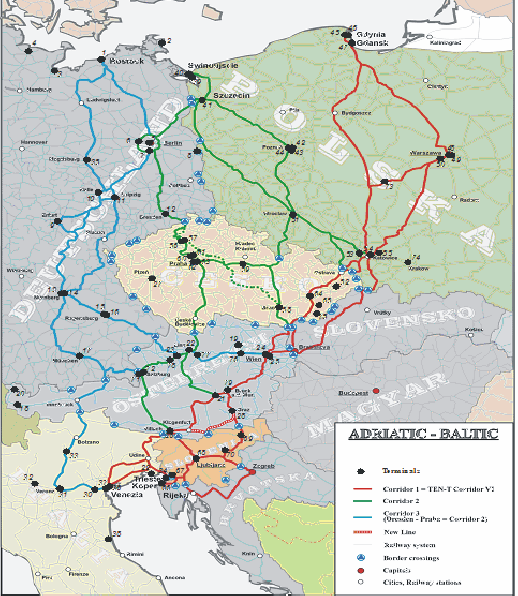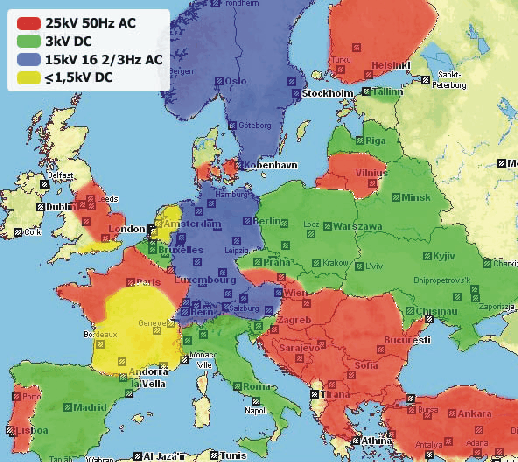|
|
|
TECHNICALLY-INFRASTRUCTURAL CONDITIONINGS OF THE REALIZATION OF INTERMODAL TRANSPORT CONNECTING THE BALTIC SEA WITH THE ADRIATIC SEA Maciej Stajniak ABSTRACT Free intermodal transport of loads between the Baltic Sea and the Adriatic Sea is possible under the condition that the transport infrastructure in each country is described by the same technical parameters. Unfortunately, the existing infrastructure was shaped by the countries' supreme decisions and regulated by laws for sustainable transport development in corridors of a special meaning to EU transport development. The study presents technical - infrastructural barriers for intermodal transport in each country INTRODUCTION Observations of the intermodal transport market show that there are many factors that cause low competitiveness of intermodal transport. These are all technical, economical and administrational barriers that lengthen the driving time and, as a consequence, make it impossible for the haulier to meet the expected service level which is understood as punctuality and reliability. The European Union, as it understands the importance of freight transport being a significant European economic growth factor, is trying hard to keep the growth tendencies, redressing the balance between transport modes. It wants to keep the markets accessible and reduce transport's harmful influence on the natural environment. It also supports intermodal investments by eliminating their development barriers in new member countries and facilitates sustainable transport policy development by making certain decisions. THE PROBLEMS OF INTERMODAL TRANSPORT DEVELOPMENT IN THE NORTH-SOUTH RELATION The European freight transport market in the North-South relation has been characterized by stable growth for many years. What is alarming is that the growth is totally predominated by road transport, whereas, the other transport modes are in decline. Losing customers (caused by larger use of heavy trucks) is particularly noticeable in case of railway and intermodal transport. It results from i.a. development barriers, out of which the most important are:
Low punctuality of road-rail transport is alarming. It is estimated that only ca. 60% of intermodal trains reach their points of destination. Low punctuality results from too small number of regular, shuttle block trains which should handle only two end stations with an unchanged set of cars. However, it is common to connect and disconnect railway cars and direct each car or group of cars to several points of destination, which makes the delivery time longer [Neider 2006].
In order to improve time competitiveness of intermodal transport it is necessary to implement standard solutions which are:
Figure 1 shows three intermodal corridors which connect the Baltic Sea with the Adriatic Sea, however, the article has been devoted to transport conditions in corridor 1 countries. BARRIERS OF DEVELOPMENT OF INTERMODAL TRANSPORT IN THE COUNTRIES CONNECTING THE BALTIC SEA WITH THE ADRIATIC SEA The key barrier in international railway transport that makes it difficult to use railway in the North-South relation is different voltage in the wires in each country [Mindur L. et. al. 2007]. It can only be eliminated by using either multi-system engines or diesel ones.
Intermodal transport uses mainly railway network. Therefore, the regulations and traffic control systems must be unified in a way that eliminates bottlenecks of its network and improves intermodal transport. The bottlenecks are mainly:
The condition of infrastructure in each country is showed in table 1.
Intermodal connection in the North-South relation, as a very important link on the European transport route map, still has many constraints that disturb free load flow via each country. Hence, it is important to implement EU standards which ensure compatibility of traffic management systems and elimination of barriers of maintaining constant speed on the whole route in each country. Intermodal transport improvement is only possible with efficient railway infrastructure for carrying containers, semi trailers and swap bodies. The first country of the corridor connecting the Baltic Sea with the Adriatic Sea is Poland, where the infrastructure is managed by PKP Polskie Linie Kolejowe S.A. (Polish Railway Lines Joint Stock Company). The railway network has a standard gauge and the wires are supplied by a voltage of DC 3 kV, with maximum speed of up to 100 km/h. Polish intermodal railway infrastructure has many constraints that make free load flow in the North-South corridors difficult. Good condition of tracks in Poland is important due to planned increase of loads carried by railway between the Adriatic Sea and the Baltic Sea. Poland plays a key role in the corridor because the loads will be partly carried via the country. Main disadvantages of Polish intermodal railway infrastructure are:
Polish transport policy is similar to most European countries. It is based on balanced transport development and increase of railway/intermodal transport. Now, 522 km of railway trucks are being repaired and modernized and another 1996 km will be modernized in the future. The effectiveness of the repairs depends on EU funds and the state policy on intermodal railway infrastructure development. In the nearest 20 years it is planned to spend over 28.2 billion EUR on modernization of 6000 km of railway lines. In years 2007 - 2013 within the "Infrastructure and Environment" Programme 4,76 billion EUR have been reserved for railway investments which account for 25% of the total railway infrastructure modernization budget. It will contribute to meeting European standards of 160 km/h speed and increasing maximum axle load to 22.5 t and elimination of speed variability on the route. The Czech Republic is, after Poland, the second country of the Baltic-Adriatic corridor. The Czech section of the corridor is 214 km long. The line is double and electrified in the north part by DC 3 kV (161 km) and in the south part by AC 25 kV/50 Hz (53 km). The Czech railway infrastructure is managed by a state company SDC, which is independent from the national ČD České Dráhy. The infrastructure development is financed from the state budget and international projects/funds. Modernization of line from Poland to Letohrad is a priority investment in the nearest years due to a possibility of freight increase in the north-south relation. Current problems of Czech intermodal railway infrastructure are defined in the Transport Development Programme for years 2007 - 2013 and they are:
The problems that significantly constrain the capacity on North-South corridor lines are mainly two supply systems 3 kV and AC 25 kV 50 Hz, three communication systems and variable speed limits on the lines. Modernization plans within the State Transport Policy for years 2007-2013 assume further improvement of the railway infrastructure, which will increase maximum speed limits for intermodal freight trains. The budget for railway lines modernization investments is planned at the level of 2.8 billion EUR. Austria is the third Baltic-Adriatic corridor country. The Austrian railway infrastructure is managed by ÖBB Infrastruktur Betrieb AG ÖBB Infrastruktur Betrieb AG (Austrian Railway Infrastructure, joint-stock company). The network consists of approximately 1400 working stations (railway stations, stops) and 5656 km of railway lines. 5300 km are of standard gauge (1,435 mm) and 316 km are narrow-gauge (760 - 1,000 mm) [Network Statement 2007]. Intermodal railway infrastructure consists of double and electrified lines (AC 15 kV 16.7 Hz), adjusted to the speed of 140 km/h. The technical condition of Austrian railway network is good. It is modern and fully efficient. Investments in railway infrastructure till 2012 will be almost 20 billion EUR. First, a new connection between Graz and Celowiec will be constructed and line Vienna-Passau will be modernized. The priority is the tunnel through the Alps and intermodal transport, mainly the RO-LA system on route Salzburg - Villach. There are plans to activate a direct train between Trydent and Munich. The RO - LA transport system is preferred is order to reduce road transport traffic in the Alps. Slovenia is another Baltic-Adriatic corridor country. The railway infrastructure is 128 stations, 972 railway crossings with paths and cross-walks, including 315 secured railway crossings on the lines. Moreover, the infrastructure manager maintains 3181 bridges and flyovers and 93 tunnels. Almost all lines are electrified and supplied by 3 DC kV, except the border with Austria (DC 15 kV 16.67 Hz) and Croatia (AC 25 kV 50 Hz). The electrified lines account for ca. 41% of the total railway network. Intermodal railway infrastructure in Slovenia is well developed, allowing to carry loads at the maximum speed of 120 km/h. The only difficulty in international transport is different voltage in the wires in neighbour countries. Italy is the last country of the Baltic-Adriatic corridor. The intermodal railway network is managed by RFI (Ferrovia Italiana Networks). The length of the network is 19788 km. The Baltic-Adriatic corridors run only in the north-east part of Italy and account for about 850 km of the lines. The lines are supplied by DC 3 kV, with automatic block signalling, appropriate for the maximum speed of 140 km/h. The Italian intermodal railway infrastructure is in good technical condition. There is, however, a small problem, i.e. the efficiency in the corridor, i.a. from the Slovenian border towards Triest and Venice due to big load flows. The railway connection to Slovenia (Bivio Aurisina - Seana) is another problem due to the speed limit of 85 km/h. The Alps and numerous tunnels are a serious constraint for freight transport due to the speed limits of up to 50 km/h. Moreover, the inclination on routes is up to 26o and there is a necessity of using a second engine in order to stop the train when going down-hill and support it when going up-hill [Corridor-specific Reports]. Freight transport conditions will be improved as a result of the infrastructure development strategic plans in years 2007 - 2013 elaborated by CIPE (Italian Interministerial Economic Planning Committee), which concern i.a.:
Moreover, there are plans of constructing new railway lines which will balance the transport system and strengthen the role of railway freight transport by providing high-speed trains meeting basic safety standards and offering shorter driving time. CONCLUSIONS Transport policies of the Baltic-Adriatic corridor states are similar and aim at sustainable transport development and increase of railway/intermodal transport. The development, however, is not simple, due to many constraints of the intermodal railway infrastructure which make free loads flow in the North-South transport corridors difficult. The fact that the European Commission accepted a Polish combined transport development programme in January 2007 is a chance for the Polish section of the corridor. The programme is supposed to result in a 7% increase in transport carriages. The budget of the programme, which is planned to be implemented by the end of 2008, will be 31,6 million EUR. The money will be spent on building and extending the intermodal transport infrastructure, purchasing the equipment and modern technologies including building an intermodal transport terminal on the border crossing in Międzylesie. The terminal would handle loads from Baltic ports in southern Europe. Financial means from EU as well as the means guaranteed in the transport development programmes of each state are a chance of eliminating some of the constraints of the North-South corridor countries. In the future they will contribute to meeting European standards of 160 km/h on most routes, increasing the maximum axle load to 22.5 t., making traffic control systems compatible, making communication systems uniform, purchasing multi-system engines which are independent from different voltages in the wires and eliminating variable speed on routes. In the short run it is impossible to eliminate the technical and infrastructural barriers in the corridor due to the fact that the modernization plans in each country are based on EU means. It means that year 2013 is the deadline for modernization and elimination of the barriers and bottlenecks of intermodal transport. REFERENCES Liberadzki B., Mindur L. et. al., 2006, Polish transport system development conditions, , SGH, ILiM, Institute of Technology and Exploitation - PIB, Warsaw. Mindur L. et. al., 2007, Europe - Asia. Economy, transport, ILiM, Poznań. Neider J., 2006, Transport in international trade, University of Gdańsk Publishing, Gdańsk. Project Trend. Corridor-specific Reports, Deliverable Work Package B2 TECHNICZNO-INFRASTRUKTURALNE UWARUNKOWANIA REALIZACJI PRZEWOZÓW INTERMODALNYCH ŁĄCZĄCYCH MORZE BAŁTYCKIE Z MORZEM ADRIATYCKIM
STRESZCZENIE Swobodny przepływ ładunków transportem intermodalnym łączący Morze Bałtyckie z Morzem Adriatyckim jest możliwy pod warunkiem, że infrastruktura transportowa w poszczególnych krajach będzie się charakteryzowała takimi samymi parametrami technicznymi. Niestety, obecna infrastruktura kształtowana była w myśl suwerennych decyzji państw i poddawana pewnym regulacjom dotyczącym zrównoważonego rozwoju transportu w korytarzach o szczególnym znaczeniu dla rozwoju transportu na terenie UE. Praca prezentuje bariery techniczno - infrastrukturalne w przewozach intermodalnych przez terytorium poszczególnych krajów. TECHNISCH-INFRASTRUKTURELLE VORAUSSETZUNGEN DER INTERMODALEN VERKEHRE IM OSTSEE - ADRIA KORRIDOR
ZUSAMMENFASSUNG. Freier Güterfluss mithilfe von intermodalen Verkerhren, die die Ostsee mit dem Adriatischen See verbinden, ist nur dann möglich, wenn die Verkehrsinfrastruktur in den einzelnen Ländern gleiche technische Parameter aufweist. Die jetzige Infrastruktur wurde durch souveräne Entscheidungen der Länder gestaltet. Darüberhinaus wurde die ausgewogene Entwicklung des Transports in den Transportkorridoren mit besonderer Bedeutung für die Entwicklung des Transports in den EU Ländern durch bestimmte Regelungen beeinflusst. Der Beitrag präsentiert technisch-infrastrukturelle Barierren in den intermodalen Verkehren durch das Territorium der einzelnen Länder. Maciej Stajniak, PhD |
Copyright © 2005 LogForum, Wyższa Szkoła Logistyki, ul.E.Estkowskiego 6, tel. 061 852 95 55, 851 06 04, tel./fax. 061 851 06 03 |


